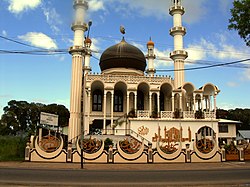According to the official data, the Muslim population of Suriname represents about 13.9 percent of the country's total population as of 2012, which is the highest percentage of Muslims in the Americas. Though the majority belong to the Sunni sect of Islam, there are some Shi'a
 | |
| Total population | |
|---|---|
| 13,9% of the total population in 2012 | |
| Regions with significant populations | |
| Commewijne · Nickerie · Wanica · Saramacca | |
| Religions | |
| Sunni Islam · Ahmadiya (including the Lahore Ahmadiyya Movement) · Other Muslim | |
| Languages | |
| Arabic (liturgical language) Surinamese Dutch · Surinamese-Javanese · Sarnami Hindustani | |
| Related ethnic groups | |
| Dutch Muslims · Guyanese Muslims · Trinidadian and Tobagonian Muslims · Jamaican Muslims · Antillian Muslims |
Some speculate that Muslims first came to Suriname as slaves from West Africa and then were converted to Christianity over time, even though there is little proof for these speculations. The ancestors of the actual Muslim population came to the country as indentured laborers from the British Raj and Dutch East Indies, from whom today most Muslims in Suriname are descended.
The forms of Islam in Suriname are strongly influenced by the culture of the regions of origin: South Asia (India, Pakistan and Afghanistan)[1] and Indonesia (Java). Apart from descent, most Surinamese Muslims also share the same culture and speak the same languages.
East-west divide
editThe first Javanese Muslims to come to Suriname built their mosques facing west as they did in Java. It was only until contact with Hindustani Muslims in the 1930s that people realized that Mecca is east of Suriname. This created a divide between Muslims who prayed to the east (wong ngadep ngetan) and west (wong ngadep ngulon). The east-worshipping Muslims were more orthodox in their religion, whereas those who worshipped to the west were Javanese and clung more to their traditional Javanese culture.[2]
Demographics
editThere are 75,053 Muslims in Suriname, according to the 2012 census.[4] This number is up from 66,307 Muslims in 2004. The share of Muslims of Indo-Surinamese descent decreased from 17% to 13% in the same period (-4%), mainly because of emigration to the Netherlands and declining fertility rates. The share of Muslims among Maroon people doubled from 0.1% to 0.2%.[citation needed]
| Year [5] | Suriname (population) | Muslim population | Share (%) |
|---|---|---|---|
| 1964 | 324,893 | 63,809 | 19.6% |
| 1971 | 379,607 | 74,170 | 19.5% |
| 1980 | 355,240 | 69,713 | 19.6% |
| 2004 | 492,829 | 66,307 | 13.5% |
| 2012 | 541,638 | 75,053 | 13.9% |
Ethnic groups
editIslam is the main religion among Javanese Surinamese people (67%) and the second largest religion among Indo-Surinamese people (13%) and multiracial people (8%).
| Islam by ethnic group as of 2012 | ||||||||||||||||||
|---|---|---|---|---|---|---|---|---|---|---|---|---|---|---|---|---|---|---|
| Ethnic group | Population | Muslims | % | |||||||||||||||
| Javanese Surinamese | 73,975 | 49,533 | 67.0% | |||||||||||||||
| Indo-Surinamese | 148,443 | 18,734 | 12.6% | |||||||||||||||
| Multiracial people | 72,340 | 5,471 | 7.6% | |||||||||||||||
| All Afro-Surinamese | 206,423 | 621 | 0.3% | |||||||||||||||
| Amerindians | 20,344 | 138 | 0.7% | |||||||||||||||
| Chinese Surinamese | 7,885 | 112 | 1.4% | |||||||||||||||
| White Surinamese | 1,665 | 32 | 1.9% | |||||||||||||||
| Others and indefinable | 10,561 | 412 | 3.9% | |||||||||||||||
Geographical distribution
editCommewijne District has the highest share of Muslims (mostly Javanese Surinamese), followed by Nickerie District and Wanica District (mostly Indo-Surinamese).
| Share of Muslims by district according to 2004 Census | |
|---|---|
| District | Percent of Muslims |
| Commewijne District | 40.4% |
| Nickerie | 22.5% |
| Wanica | 21.7% |
| Saramacca | 18.8% |
| Para | 11.3% |
| Coronie | 11.0% |
| Paramaribo | 9.4% |
| Marowijne | 6.8% |
| Brokopondo | 0.2% |
| Sipaliwini | 0.1% |
| Suriname | 13.5% |
International
editSuriname (since 1996) and Guyana (since 1998) are the only countries in the Americas which are member states of the Organisation of Islamic Cooperation.[6]
Notable Muslims
editThis article's list of residents may not follow Wikipedia's verifiability policy. (August 2024) |
- Rashied Doekhi, politician
- Paul Somohardjo, politician
See also
editReferences
edit- ^ "The Afghan muslims of Guyana and Suriname".
- ^ Hoefte, Rosemarijn (2015). "Locating Mecca: Religious and Political Discord in the Javanese Community in Pre-Independence Suriname". In Yelvington, Kevin A.; Khan, Aisha (eds.). Islam and the Americas. University Press of Florida. pp. 69–91. ISBN 978-0-8130-6013-2.
- ^ "Censusstatistieken 2004" (PDF). Algemeen Bureau voor de Statistiek. Retrieved 25 August 2022.
- ^ "Algemeen Bureau voor de Statistiek" (PDF).
- ^ "Muslim Population in the Americas: 1950 – 2020" (PDF). p. 7.
- ^ "Member States of the Organisation of Islamic Cooperation". Archived from the original on 9 December 2013. Retrieved 18 July 2013.
- "Mirza Ghulam Ahmad and the Qadiyani Sect : Imaam al-Albaanee". AbdurRahman.Org. 15 January 2014. Retrieved 15 August 2024.
Further reading
edit- Bal, Ellen; Kathinka Sinha-Kerkhoff (August 2005). "Muslims in Surinam and the Netherlands, and the divided homeland" (PDF). Journal of Muslim Minority Affairs. 25 (2): 193–217. doi:10.1080/13602000500350637. hdl:1871/33761. S2CID 18379751.